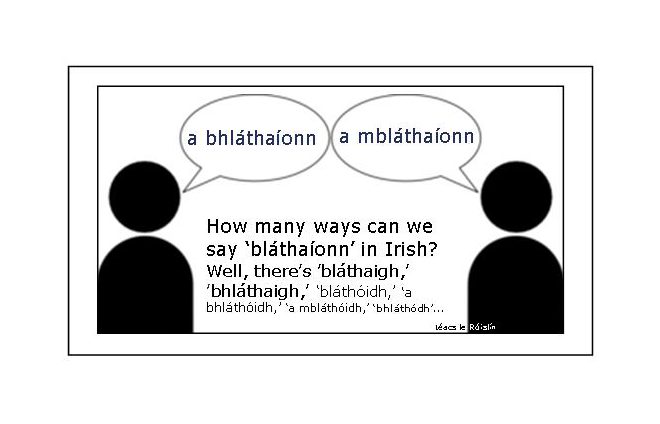Pronunciation Guide for ’30 Teideal Scannán’ — Flower Terms and Miscellaneous Irish Pronunciation Posted by róislín on Jun 5, 2016 in Irish Language
(le Róislín)
Before wrapping up our recent films and flowers theme, I figured it might be helpful to look at a couple of the more unusual pronunciations. So here are my top ten contenders for the least intuitive spellings of the phrases we used recently.
As you can see, some of the phrases are a little more awesome-looking because they have mutations at the beginning to show changes in how the words are used in the sentence. If we look at “gáma-ghathanna” instead of “ngáma-ghathanna,” it’s not quite so complex. Similarly “Trá Lí” is probably more familiar-looking than “Thrá Lí” and likewise, “bláthaíonn” instead of “a bhláthaíonn” or “a mbláthaíonn.” But nevertheless, this is exactly what Irish does all the time. “Madra” (dog) becomes “mhadra” (say: WAH-druh) in phrases like “mo mhadra” (my dog) and “Gaillimh” becomes “i nGaillimh” (say: ing-AHL-yiv) for “in Galway.” Welcome to Irish!
1) claíomh, three vowels in a row, but one of them has the long mark, so that’s the one that really tells us how to pronounce the word: kleev. This word is a distant cousin of the Latin ‘gladius,’ a clue to its meaning, which is “sword.” (An Claíomh agus an Rós)
2) na dTiúilipí, from the phrase “Aimsir na dTiúilipí. If start with the basics, we have “tiúilip” (a tulip), “tiúilipí” (tulips), and finally, “na dtiúilipí [nuh DyOO-lip-ee]” (of the tulips). The key point is that the letter “t” is silent once it gets covered over with the letter “d” (because of the “urú“). Also, this is a “slender” d, so it’s more like the Irish and British pronunciation of words like “dew” or “duke,” which I have indicated with the superscript “y.” Of course, it’s also the slender “d” of thousands of Irish words, like “deas” or “deisigh” or “Diarmaid,” but my point is that we do have this sound in English as well. This “d” sound is not the pronunciation John Wayne would have used for “duke” if he had said he was going to “duke it out with someone.”
Remember also, “aimsir” can mean “time” as well as “weather,” so this phrase literally means, “the time of the tulips.” (An Ollainn in Aimsir na dTiúilipí)
3) Luaithríona, based on the word “luaith [LOO-uh]” (ashes), this is the Irish for “Cinderella.” The “th” is silent in both words; there may be a slight puff of breath as it’s pronounced, but not much. The ending is as in names like Caitríona or Lasairíona. (An Slipéar agus an Rós: Scéal Luaithríona)
4) na nGáma-ghathanna. First, let’s undo the urú (which changed the first “g” to “ng.” Let’s also undo the séimhiú that changed the second “g” to “gh”. Then let’s split the compound word apart, and we simply have “gáma” [GAW-muh] and “gathanna” [GAH-huh-nuh], the plural of “ga,” which means “a ray.”
With the mutations, we have an “ng” sound as in “singing” and a “gh” sound that doesn’t exist in English. This “gh” is a bit like the guttural “ch” in “Chutzpah” or “Challah” or “das Buch” or Welsh “bobl bach,” but it’s a little softer and deeper in the throat. It occurs constantly in Irish, in phrases like “An Ghaeilge,” “a Ghráinne,” “a ghrá,” and “mo ghúrú” (my guru). Phonetically, it’s the voiced velar fricative, show in IPA as /ɣ/, but I’ll just stick to using the “gh” here. So for “na nGáma-ghathanna,” say “nung-AWM-uh-GHAH-huh-nuh.” The “t” is completely silent. Its meaning is pretty straightforward, all things considered– “gamma-rays.” Those “uh’s” are pronounced like the “u” in “fun” or the “a” in “about” (not as in “put” or as in the German “Huhn“). (Éifeacht na nGáma-ghathanna ar Phlandaí Ór Muire Dónall-na-Gealaí)
5) Cruach, say “KRrOO-ukh,” meaning “steel” or “of steel.” Here we have the “flapped” (slightly trilled) Irish “r” and the “ch” sound described above (as in Chutzpah, Challah, das Buch, and bobl bach). (Magnóilianna Cruach)
6) Ná hIth, say: “naw hih,” with the second “h” just like a bit of breath. The “t” is completely silent. Why do we have that initial “h” anyway (if “Ith!” means “Eat!”)? “Ná” here means “don’t” and it causes an “h” to be prefixed before vowels. We see this also in “Ná hól sin!” (Don’t drink that!) and “Ná habair é!” (Don’t mention it!). (Ná hIth na nóiníní, le do thoil!)
7) a Bhláthaíonn, as in Nuair a Bhláthaíonn Na Poipíní Arís. From the verb “bláthaigh” ([BLAW-hee], bloom, blossom), based on “bláth” (a flower). “Bláthaíonn” ([BLAW-hee-un]) means “blooms” (as in “This flower blooms in April”). In this movie title, we have séimhiú after “nuair a,” so the phrase is pronounced “uh VLAW-hee-un.”
8) ina mBláthaíonn, as in An Áit ina mBláthaíonn na Lilí (lit. the place in which the lilies bloom). Here we have urú, changing the initial “b” to “mb,” so we say “IN-uh MLAW-hee-un.” The “b” is silent and only the inital “m” is now pronounced.
9) ar an nGaoth, meaning “on the wind,” from “gaoth” (wind). Say: erzh ung EE. The “th” is silent and the “ng” really flows from the preceding “n” sound. (Peitil ar an nGaoth).
10) Thrá Lí, meaning “of Tralee.” The only tricky thing is the “t” is now silent, because of the séimhiú. So the initial sound is really like “hraw,” with a flapped “r”, giving us “hrraw lee.” (Rós Thrá Lí).
I hope that was helpful. Of course, if all of these movies were dubbed into Irish, all we’d have to do is listen! — Róislín

Build vocabulary, practice pronunciation, and more with Transparent Language Online. Available anytime, anywhere, on any device.





Leave a comment: